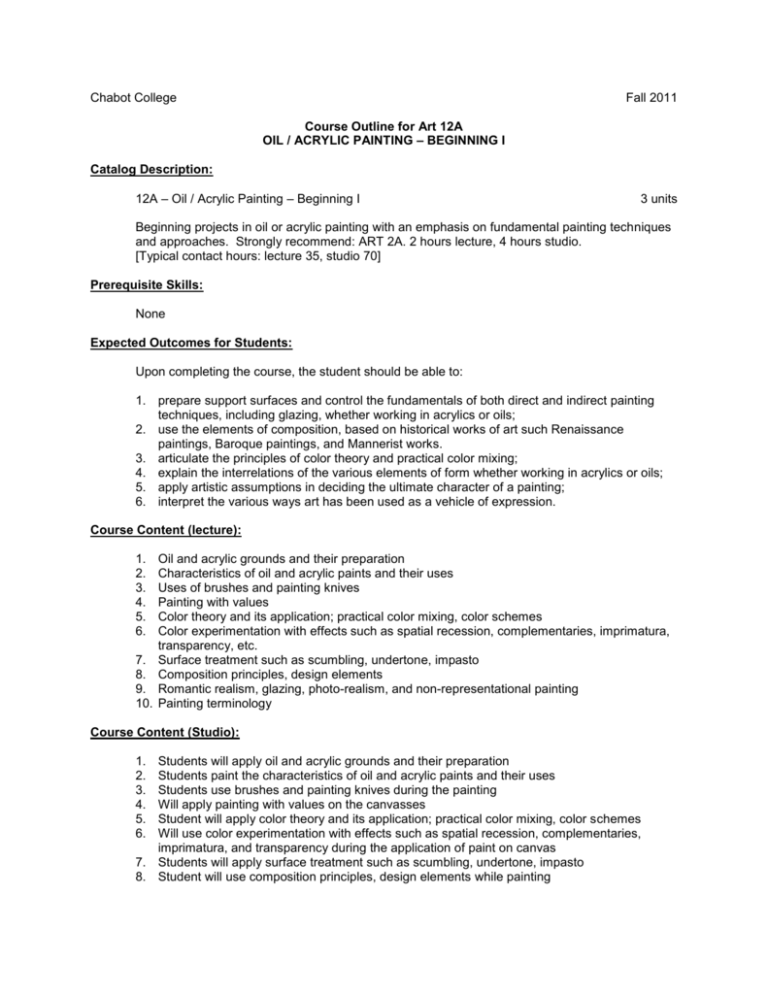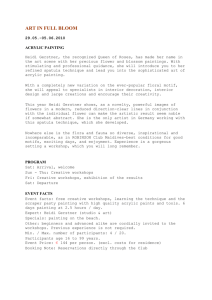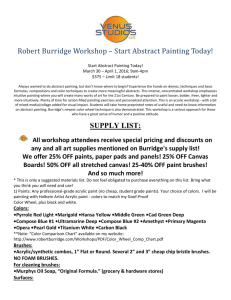Oil/Acrylic Painting - Beginning I
advertisement

Chabot College Fall 2011 Course Outline for Art 12A OIL / ACRYLIC PAINTING – BEGINNING I Catalog Description: 12A – Oil / Acrylic Painting – Beginning I 3 units Beginning projects in oil or acrylic painting with an emphasis on fundamental painting techniques and approaches. Strongly recommend: ART 2A. 2 hours lecture, 4 hours studio. [Typical contact hours: lecture 35, studio 70] Prerequisite Skills: None Expected Outcomes for Students: Upon completing the course, the student should be able to: 1. prepare support surfaces and control the fundamentals of both direct and indirect painting techniques, including glazing, whether working in acrylics or oils; 2. use the elements of composition, based on historical works of art such Renaissance paintings, Baroque paintings, and Mannerist works. 3. articulate the principles of color theory and practical color mixing; 4. explain the interrelations of the various elements of form whether working in acrylics or oils; 5. apply artistic assumptions in deciding the ultimate character of a painting; 6. interpret the various ways art has been used as a vehicle of expression. Course Content (lecture): 1. 2. 3. 4. 5. 6. 7. 8. 9. 10. Oil and acrylic grounds and their preparation Characteristics of oil and acrylic paints and their uses Uses of brushes and painting knives Painting with values Color theory and its application; practical color mixing, color schemes Color experimentation with effects such as spatial recession, complementaries, imprimatura, transparency, etc. Surface treatment such as scumbling, undertone, impasto Composition principles, design elements Romantic realism, glazing, photo-realism, and non-representational painting Painting terminology Course Content (Studio): 1. 2. 3. 4. 5. 6. Students will apply oil and acrylic grounds and their preparation Students paint the characteristics of oil and acrylic paints and their uses Students use brushes and painting knives during the painting Will apply painting with values on the canvasses Student will apply color theory and its application; practical color mixing, color schemes Will use color experimentation with effects such as spatial recession, complementaries, imprimatura, and transparency during the application of paint on canvas 7. Students will apply surface treatment such as scumbling, undertone, impasto 8. Student will use composition principles, design elements while painting Chabot College Course Outline for Art 12A, Page 2 Fall 2011 9. Students will paint pictures based on Romantic realism, glazing, photo-realism, and nonrepresentational painting Methods of Presentation: 1. 2. 3. 4. Studio lectures, discussion and demonstrations Examples of student and professional work Slides and videos Museum and/or a gallery visit with an appropriate exhibition Assignments and Methods of Evaluating Student Progress: 1. Typical Assignments a. Paint a picture based on the art sequence of large to small. Lay in the large, major shapes that define the overall composition of the painting then put in the intermediate shapes that begin to refine and clarify the overall painting. The third step is to paint the detailed, small shapes that complete the painting. b. Paint a picture based on the concept of transparent layers, which is called glazing. Use only glazed down colors and never combine with white paint. White may be used separately and after drying, may be glazed over with color, which must always be transparent, thinned paint. c. Define the following terms: 1) hue 2) shape 3) glaze 4) line 5) primary color 6) broken color 2. Methods of Evaluating Student Progress: a. Assigned projects, comprehension and application of the terms and concepts of each project b. Class work c. Student output d. Development of craftsmanship e. Overall presentation and professionalism in presenting completed painting projects f. Final examination or project Textbook(s) (Typical): The Artist’s Handbook, Ray Smith. DK Publishing, Inc., October 2009 The Painter’s Handbook, Mark David Gottsegen, Watson-Guptill, April 2006 Special Student Materials: 1. 2. 3. 4. acrylic or oil paints canvases and stretcher bars brushes and mediums various applicable materials DZ g:\Curriculum2005\Art12A Revised: jkomisar 09/10









